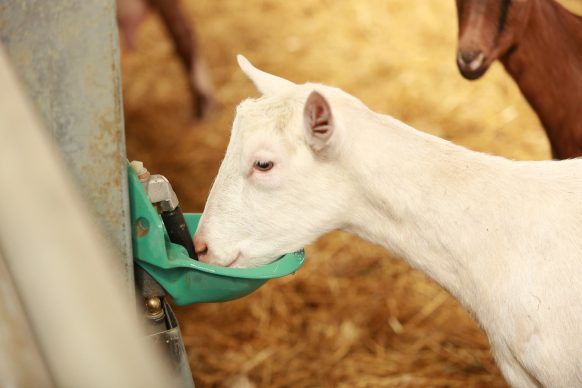
Click here for a PDF of this issue of the Goat Gazette.
Water is essential to maintaining your herd’s health and productivity. Overall, goats are more particular about water quality than other livestock, so cleanliness and freshness is very important to ensure goats are consuming enough water. Goats may refuse dirty water, leading to dehydration and reduced feed intake, health complications, and possibly death. It takes 1.9 litres of water to produce 1 litre of milk – “Milk is mainly water, after all.” says Marlene Paibomesai, dairy specialist with the Ontario Ministry of Agriculture and Rural Affairs (OMAFRA).
To ensure your goats are getting enough water, check all waterers at least daily. If you have automatic waterers, ensure they are working. Dumping and rinsing of water bowls should be done daily, with complete cleaning done once a week, or as soon as they become dirty. Goats will not drink out of a bowl that has manure in it. Scrub and disinfect water bowls at least weekly, or as soon as algae, feed, manure, or other buildup is present. If a small animal such as a mouse drowns or defecates in the water, clean and disinfect the bowl immediately. Depending on factors such as the number of goats using a water bowl, size of water bowl, and pen design, you may need to rinse and disinfect water bowls more frequently. The goal should be to have clean, fresh water available to all your goats at all times.
Steps for cleaning water bowls
- Drain the water completely. Try to avoid dumping it out where your goats stand. Avoid creating slippery footing and stagnant pools of water in this high traffic area.
- Use a stiff brush to scrub the entire bowl. Feel the water bowl before and after you scrub it. Scrubbing should eliminate any slimy feeling. That slime is bacteria buildup. Use soap if scrubbing doesn’t eliminate the slimy feeling. A mild detergent such as dish soap works well. Rinse this away before using a disinfectant. The presence of organic material such as bedding, feed, or manure interferes with the effectiveness of disinfectants. For this reason, you need to clean dirt and grime from surfaces before you disinfect them. Applying disinfectant to a dirty surface will not be effective.
- If needed: disinfect the water bowl with an appropriate product (see more details below).
- Rinse, rinse, rinse! Be sure all soap and disinfectant residue is removed from the water bowl. Rinse with drinking quality water until there are no suds in the water bowl.
Choosing a disinfectant
Water analysis can also help you select the most suitable disinfectant for your farm. Things like hard water, water pH, and water temperature can impact the efficacy of disinfectant. Be sure to read the label to determine if the disinfectant is appropriate for your water and safe for your surfaces and herd. Following the label instructions regarding use is also important to maximize effectiveness. For information about specific disinfectants, see Alberta Agriculture and Forestry’s “Clean and Mean: Effective Targeting for Disinfectants and Disinfectant Combinations” here.
Is your water clean?
Having clean water bowls is only effective if the water you put in them is also clean. It is recommended you carry out at least yearly water analysis to test for bacterial contamination of water sources. Water quality can vary throughout the year, so test at times when contamination is likely such as during spring run off or after a heavy rain fall. You should also run water quality analysis if you notice any changes in the water colour or smell. Testing for water quality is very important for producers using well water but even if you are using municipal water, you should monitor water quality, as there are a variety of factors that can contaminate water before it arrives in your goat’s water bowl.
In dairy facilities, it is required that water used to supply the milk house, clean equipment, and feed your animals meet the same standards as drinking water. Ontario Drinking Water Standards describe potable water as having zero E.coli and zero coliforms per 100 ml. Coliforms, such as E. coli, are an indication of fecal contamination of the water supply, and can increase the risk of diseases such as mastitis in the herd. More information on water quality and testing can be found in Ontario Goat’s “Best Management Practices for Commercial Goat Production.”
Summary
Water is one of the most important and economical inputs for your goat operation. Providing goats with a clean water bowl is essential to encouraging them to drink enough water to stay healthy and productive. When assessing if a water bowl is clean enough, as yourself, “Would I drink water out of this bowl?” If the answer is “No” – grab your scrub brush!
For more information on facilities, management and best practices, consult the Ontario Goat Best Management Practices manual, visit our resources page or contact us.
